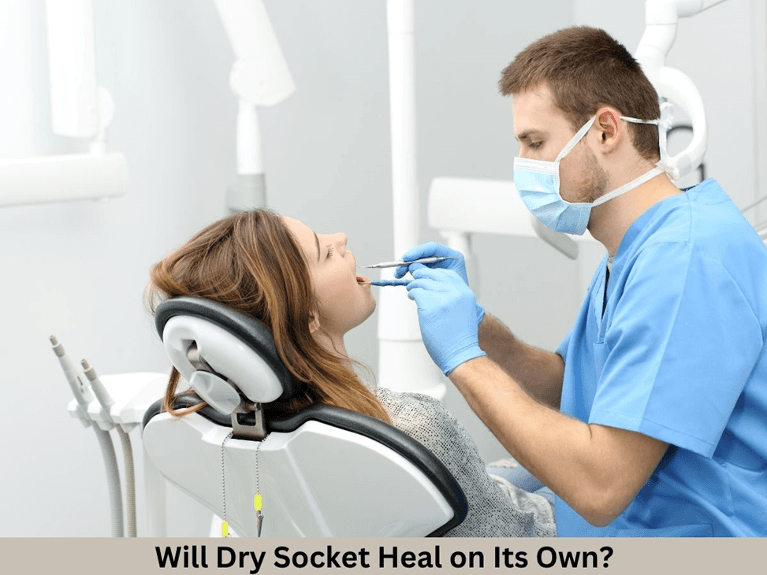
The dry socket is a common condition that usually follows after tooth extraction, with an overall incidence of 3.2% in young adults. From the healing timeline to symptoms and treatment, the following article will discuss this post-tooth removal complication in detail.
What is a Dry Socket?
Fibrinolytic osteitis, or alveolar osteitis, known as dry socket, is an infection associated with the lower tooth extraction.
Just like a dry, rough crust forms on the skin during the initial stages of wound healing, in the same way, a blood clot covers the extraction site in our mouth after tooth removal. This clot protects the bones or nerve endings of the gum tissue against bacteria, which speeds up the recovery process in return.
Sometimes, the clot dissolves or dislodges from the site of a wound, exposing the gum tissue to foreign particles. It results in a painful dental condition we refer to as the dry socket. You can expect it to form within one to four days after the extraction and last until the closure of gum tissue around the wound. Moreover, it can be a complete or partial dry socket, depending on the portion of a blood clot that gets affected.
What Causes a Dry Socket?
According to a research study, the dry socket lesion appears in almost 1 to 5% of all tooth extractions except for wisdom tooth removal, where the chances of occurrence rise to about 38%. Several other causes leading to this complication are:
- Use of oral contraceptive pills
- Pressure changes in the mouth, such as aggressive rinsing or the use of straws
- Heavy smoking
- Gender (dry socket is 50% more prevalent in females)
- Surgery at the hands of an inexperienced dentist
Symptoms
The empty socket without a blood clot almost always indicates the possibility of a dry socket. However, the intensity of symptoms may vary for each individual. Some common symptoms include:
- Throbbing pain at the extraction site after 2-4 days of surgery
- Extended discomfort in the ear, eye, or temple on the same side
- Bad breath (halitosis) due to a smelling wound
- Unpleasant taste in the mouth
Will Dry Socket Heal on Its Own?
Yes! The dry socket heals on its own within a week. However, the pain scale can worsen without proper medical care, leading to delayed recovery, infection, or sometimes even nerve damage. In occasional cases, the pain can even last for about forty days.
Dry Socket Self-Care Tips
Don’t worry if you are unable to manage immediate dental visits. We have listed some science-backed self-care tips you can follow at home to help relieve the inflammation or pain caused by your dry socket.
- Use clove oil: Dip a cotton swab in the clove oil and place it on the affected area for 1-2 minutes. Rinse your mouth with lukewarm water following the removal of a swab.
- Use honey: Treat a sterile gauze with raw honey. Put this dressing on the dry socket for around 5 minutes. You can replace the gauze after every few hours throughout the day.
- Use turmeric: You can mix half a teaspoon of turmeric in lukewarm water to make a paste. Apply and leave the area of infection for 15-20 minutes. Rinse your mouth with lukewarm water.
Other options include aloe vera and salt, resulting in temporary relief or sometimes even a healed dry socket.
Prevention
You can completely avoid this painful condition by following the prevention tips mentioned in the articles published by Cochrane Library, Australia. Some of them include:
- Restricting the use of tobacco
- Drinking without a straw
- Using mouthwash
- Applying eugenol post-surgery
- Gentle mouth rinsing with saltwater
If your post-surgery pain persists 2-4 days after tooth removal, there’s a high possibility that it could be due to a dry socket. In such a scenario, we highly recommend reaching out to your Brisbane dentist for a proper dental examination before it’s too late.
Contact Sleep Dentistry Brisbane For Expert Dental Care
You no longer have to avoid taking care of your teeth just because you have dental phobia or other special needs. The team at Sleep Dentistry Brisbane understands and respects all your concerns about oral health or dental treatment procedures. Whether an emergency wisdom teeth removal or post-surgery consultation, we are dedicated to providing you with a pain-free, holistic dentistry experience, just as you deserve.
Visit one of our sedation dentistry clinics near you or book a dental appointment with us whether you’re in Brisbane, Sunshine Coast, or Gold Coast.
